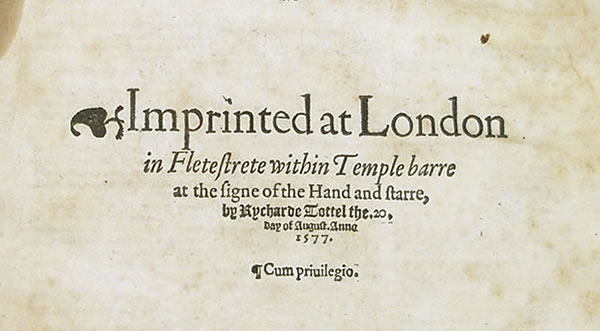
Richard Tottell held a lucrative royal patent to print law books from 1553 until his death in 1593. A royal patent was a monopoly or "privilege" granted by the King or Queen, and the right to publish under a patent was usually signified by the latin phrase cum privilegio regis or cum privilegio majestam on the title page. The exception to Tottell's monopoly were statutes, which were printed by the King's or Queen's Printer. Tottell spent his entire career working at his print shop at the "Signe of the Hand and Starre." He also took the illustration on his shop sign as his printer's device. A printer's device was an early trademark identifying a printer's work, usually a woodcut or engraving, either on the title page or final page of a book.

This address appears in the colophon of most of his editions. (A colophon is a short note at the end of a book, containing various pieces of information, but especially place of printing, printer and date.) The "Signe of the Hand and Starre" was the address of both his print shop and his home. The shop was situated quite close to the Inns of Court (the professional associations and offices of English barristers in London) and the law courts themselves.
For more information on the Inns of Court click here.
One of Tottell’s greatest contributions to legal scholarship was the regularization and integration of legal citations, and iron bibliographic control in his own printing. He standardized an uneven and somewhat confusing system of cross-referencing and created what is now considered the first real precursor to modern systems like the West Key Number System. By insisting on uniform foliation (the numbers on the leaves -- not the pages -- of a book) in all editions, Tottell made it possible to cite to the exact location of a case in related works. This permitted greater accuracy than ever before. The method is illustrated and explained in detail in this exhibit.
Tarlton Law Library is fortunate to have multiple works printed by Richard Tottell, and a strong collection of sixteenth-century English legal printing in general.

